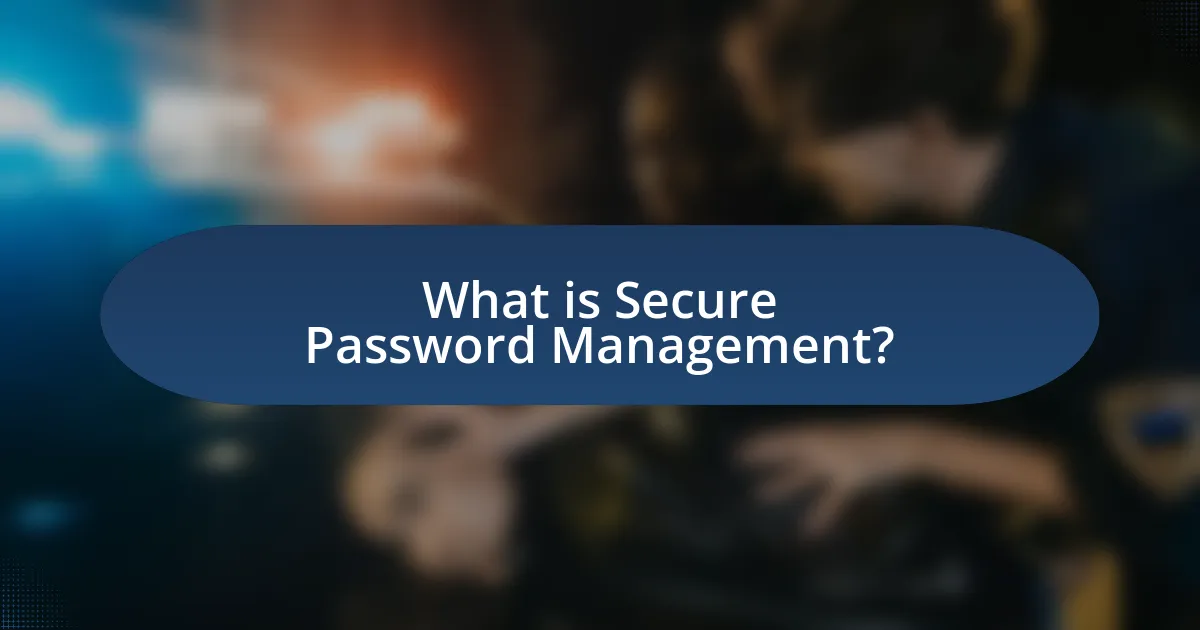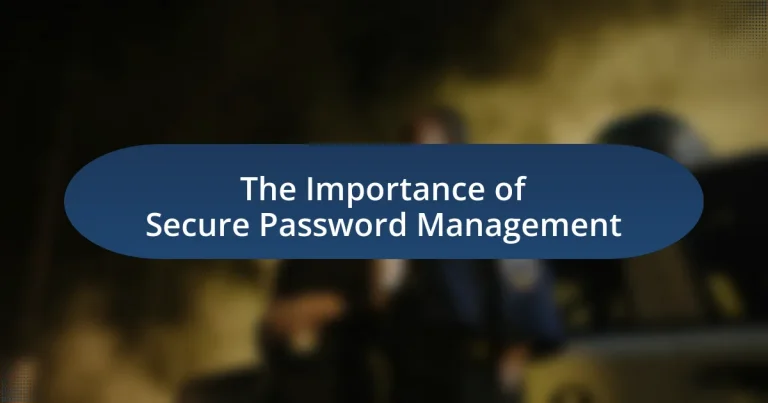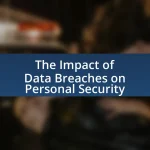Secure password management is the practice of securely storing, generating, and managing passwords to protect sensitive information from unauthorized access. This article emphasizes the critical importance of effective password management in today’s digital landscape, where weak or stolen passwords are linked to a significant percentage of data breaches. It outlines the risks associated with poor password practices, the principles of creating strong passwords, and the tools available for secure password management, such as password managers and two-factor authentication. Additionally, the article discusses the consequences of inadequate password management for individuals and organizations, highlighting the financial and reputational impacts of data breaches.

What is Secure Password Management?
Secure password management is the practice of securely storing, generating, and managing passwords to protect sensitive information from unauthorized access. This involves using tools such as password managers that encrypt passwords, ensuring that users can create complex passwords without the need to remember each one. According to a study by the National Cyber Security Centre, 81% of data breaches are linked to weak or stolen passwords, highlighting the critical need for effective password management strategies.
Why is Secure Password Management essential in today’s digital world?
Secure password management is essential in today’s digital world because it protects sensitive information from unauthorized access and cyber threats. With over 4 billion data records compromised in 2020 alone, as reported by Risk Based Security, the need for robust password management practices has never been more critical. Effective password management reduces the risk of identity theft, financial loss, and data breaches by ensuring that users create strong, unique passwords for each account and store them securely. Additionally, the use of password managers can facilitate the adoption of two-factor authentication, further enhancing security measures.
What risks are associated with poor password management?
Poor password management significantly increases the risk of unauthorized access to sensitive information. When individuals use weak passwords, reuse passwords across multiple accounts, or fail to update them regularly, they expose themselves to threats such as identity theft, financial loss, and data breaches. According to a 2021 report by Verizon, 81% of hacking-related breaches leveraged stolen or weak passwords, highlighting the critical need for robust password practices. Additionally, the use of easily guessable passwords, such as “123456” or “password,” further compounds these risks, making it easier for attackers to gain access to personal and organizational data.
How does secure password management protect personal and professional data?
Secure password management protects personal and professional data by ensuring that passwords are stored, generated, and shared in a secure manner. This practice minimizes the risk of unauthorized access, as strong, unique passwords are created for each account, reducing the likelihood of breaches caused by weak or reused passwords. According to a study by the Cybersecurity & Infrastructure Security Agency, 81% of data breaches are linked to weak or stolen passwords, highlighting the critical role of effective password management in safeguarding sensitive information. By utilizing password managers, users can also enable features like two-factor authentication, further enhancing security and protecting against phishing attacks.
What are the key principles of secure password management?
The key principles of secure password management include using strong, unique passwords for each account, enabling two-factor authentication, regularly updating passwords, and utilizing a password manager. Strong passwords typically consist of at least 12 characters, incorporating a mix of uppercase and lowercase letters, numbers, and special symbols, which significantly reduces the risk of unauthorized access. Two-factor authentication adds an additional layer of security by requiring a second form of verification, such as a text message or authentication app, making it harder for attackers to gain access even if they have the password. Regularly updating passwords helps mitigate risks from potential breaches, as compromised passwords can be rendered useless if changed frequently. Lastly, a password manager securely stores and generates complex passwords, ensuring that users do not have to remember each one while maintaining high security standards. These principles are supported by cybersecurity best practices, which emphasize the importance of robust password strategies in protecting sensitive information.
What constitutes a strong password?
A strong password is typically defined as one that is at least 12 characters long and includes a mix of uppercase letters, lowercase letters, numbers, and special symbols. This complexity makes it significantly harder for attackers to guess or crack the password using brute force methods. Research indicates that passwords meeting these criteria can take years or even centuries to crack, depending on the attack method used. For example, a study by the National Institute of Standards and Technology (NIST) emphasizes the importance of length and complexity in password creation to enhance security.
How often should passwords be changed for optimal security?
Passwords should be changed every three to six months for optimal security. This recommendation is supported by cybersecurity experts who emphasize that regular updates reduce the risk of unauthorized access, especially in light of frequent data breaches. The National Institute of Standards and Technology (NIST) advises against overly frequent changes unless there is evidence of compromise, as this can lead to weaker password practices. Therefore, a balanced approach of changing passwords within this timeframe enhances security while promoting better password management habits.
What tools and techniques are available for secure password management?
Secure password management tools and techniques include password managers, two-factor authentication (2FA), and strong password policies. Password managers, such as LastPass and 1Password, securely store and encrypt passwords, making it easier for users to generate and manage complex passwords. Two-factor authentication adds an additional layer of security by requiring a second form of verification, such as a text message or authentication app, to access accounts. Strong password policies advocate for the use of long, unique passwords that combine letters, numbers, and symbols, reducing the risk of unauthorized access. These methods collectively enhance security by minimizing the likelihood of password-related breaches.
What are password managers, and how do they work?
Password managers are software applications designed to store and manage user passwords securely. They work by encrypting passwords and other sensitive information, allowing users to access their accounts with a master password while generating strong, unique passwords for each account. This process enhances security by reducing the likelihood of password reuse and the risk of unauthorized access. According to a study by the National Cyber Security Centre, using a password manager can significantly decrease the chances of falling victim to phishing attacks and data breaches, as they promote better password hygiene and complexity.
How can two-factor authentication enhance password security?
Two-factor authentication (2FA) enhances password security by requiring an additional verification step beyond just the password. This additional layer significantly reduces the risk of unauthorized access, as even if a password is compromised, the attacker would still need the second factor, which is typically a time-sensitive code sent to a user’s mobile device or generated by an authentication app. According to a study by Google, implementing 2FA can block 100% of automated bots and 96% of targeted attacks, demonstrating its effectiveness in safeguarding accounts against unauthorized access.

How can individuals implement secure password management practices?
Individuals can implement secure password management practices by using unique, complex passwords for each account and utilizing password managers to store and generate these passwords. Research indicates that 81% of data breaches are due to weak or stolen passwords, highlighting the necessity for strong password practices. By adopting a password manager, individuals can create and maintain complex passwords without the burden of memorization, thereby reducing the risk of password reuse and enhancing overall security.
What steps can be taken to create and maintain strong passwords?
To create and maintain strong passwords, individuals should use a combination of upper and lower case letters, numbers, and special characters, ensuring that passwords are at least 12 characters long. This complexity makes it significantly harder for attackers to guess or crack passwords, as studies show that longer passwords exponentially increase the time required for brute-force attacks. Additionally, individuals should avoid using easily guessable information such as birthdays or common words. Regularly updating passwords, ideally every three to six months, further enhances security by reducing the risk of compromised credentials being exploited over time. Utilizing a password manager can also help in generating and storing complex passwords securely, minimizing the likelihood of reusing passwords across different accounts, which is a common vulnerability.
How can users effectively store and retrieve their passwords?
Users can effectively store and retrieve their passwords by utilizing password managers, which securely encrypt and organize passwords in a centralized location. Password managers, such as LastPass or 1Password, use strong encryption algorithms to protect user data, making it accessible only through a master password. According to a study by the National Institute of Standards and Technology (NIST), using a password manager significantly reduces the risk of password reuse and enhances overall security by generating complex passwords. This method not only simplifies the retrieval process but also ensures that users maintain strong, unique passwords for each account, thereby minimizing the likelihood of unauthorized access.
What common mistakes should be avoided in password management?
Common mistakes to avoid in password management include using weak passwords, reusing passwords across multiple accounts, failing to enable two-factor authentication, and neglecting to update passwords regularly. Weak passwords, such as “123456” or “password,” are easily guessable and compromise security. Reusing passwords increases vulnerability; if one account is breached, all accounts sharing that password are at risk. Two-factor authentication adds an essential layer of security that many users overlook, making accounts more secure against unauthorized access. Regularly updating passwords helps mitigate risks from potential breaches, as old passwords may be compromised without the user’s knowledge. According to a 2021 report by Verizon, 81% of hacking-related breaches involved stolen or weak passwords, highlighting the critical need for effective password management practices.
How can organizations ensure secure password management for their employees?
Organizations can ensure secure password management for their employees by implementing a combination of strong password policies, multi-factor authentication, and regular training on security best practices. Strong password policies should require complex passwords that are regularly updated, reducing the risk of unauthorized access. Multi-factor authentication adds an additional layer of security, making it more difficult for attackers to gain access even if passwords are compromised. Regular training sessions help employees recognize phishing attempts and understand the importance of password security, which is crucial given that 81% of data breaches are linked to weak or stolen passwords. By adopting these measures, organizations can significantly enhance their password management security.
What policies should be established for password creation and management?
Policies for password creation and management should include requirements for complexity, regular updates, and secure storage. Complexity requirements should mandate a minimum length of 12 characters, inclusion of uppercase and lowercase letters, numbers, and special characters to enhance security. Regular updates should enforce changing passwords every 90 days to mitigate risks from potential breaches. Secure storage policies must dictate that passwords are stored using strong encryption methods and not in plain text, reducing the likelihood of unauthorized access. These measures are supported by studies indicating that complex and regularly updated passwords significantly decrease the chances of successful cyberattacks.
How can training programs improve password security awareness among staff?
Training programs can significantly improve password security awareness among staff by providing structured education on best practices and potential threats. These programs typically include interactive sessions that cover topics such as the creation of strong passwords, the importance of password uniqueness, and the risks associated with password reuse. Research indicates that organizations implementing regular security training see a 70% reduction in security incidents related to password misuse. By engaging employees through simulations and real-world scenarios, training programs enhance retention of information and encourage proactive security behaviors.

What are the consequences of inadequate password management?
Inadequate password management leads to increased vulnerability to cyberattacks, resulting in data breaches and unauthorized access to sensitive information. For instance, a study by Verizon in their 2021 Data Breach Investigations Report indicated that 81% of hacking-related breaches leveraged stolen or weak passwords. This highlights that poor password practices can directly facilitate identity theft, financial loss, and reputational damage for individuals and organizations alike. Furthermore, inadequate password management can also lead to compliance issues, as many regulations require stringent security measures to protect personal data.
What impact can data breaches have on individuals and organizations?
Data breaches can have severe impacts on both individuals and organizations, leading to financial loss, reputational damage, and legal consequences. For individuals, a data breach can result in identity theft, financial fraud, and emotional distress, as personal information is often exposed. According to the Identity Theft Resource Center, in 2021, over 1,800 data breaches exposed more than 300 million records in the United States alone, highlighting the scale of the threat.
For organizations, the consequences include significant financial costs related to remediation, regulatory fines, and loss of customer trust. A study by IBM found that the average cost of a data breach in 2022 was $4.35 million, underscoring the financial burden on businesses. Additionally, organizations may face lawsuits and increased scrutiny from regulators, further complicating recovery efforts. Thus, the impact of data breaches is profound, affecting both personal security and organizational integrity.
How can identity theft result from poor password practices?
Identity theft can result from poor password practices when weak or reused passwords are easily compromised by cybercriminals. For instance, if an individual uses “123456” as a password, it can be cracked within seconds using automated tools. According to a 2021 report by the Identity Theft Resource Center, 1 in 5 data breaches involved compromised passwords, highlighting the direct link between inadequate password security and identity theft. When attackers gain access to personal accounts, they can steal sensitive information, leading to unauthorized transactions and identity fraud.
What financial implications can arise from security breaches?
Security breaches can lead to significant financial implications, including direct costs such as legal fees, regulatory fines, and remediation expenses. For instance, the average cost of a data breach in 2023 was estimated at $4.45 million, according to the IBM Cost of a Data Breach Report. Additionally, businesses may experience indirect costs like loss of customer trust, which can result in decreased revenue and long-term damage to brand reputation. A study by Ponemon Institute found that 60% of small businesses that suffer a cyber attack go out of business within six months. These financial repercussions highlight the critical need for secure password management to mitigate risks associated with security breaches.
What are the best practices for secure password management?
The best practices for secure password management include using strong, unique passwords for each account, enabling two-factor authentication, and regularly updating passwords. Strong passwords should be at least 12 characters long and include a mix of uppercase letters, lowercase letters, numbers, and special characters. According to a study by the National Institute of Standards and Technology (NIST), using unique passwords prevents credential stuffing attacks, where attackers use stolen credentials from one site to access accounts on other sites. Enabling two-factor authentication adds an additional layer of security, making it harder for unauthorized users to gain access. Regularly updating passwords helps mitigate risks from potential breaches, as it limits the time an attacker can exploit compromised credentials.
How can regular audits of password practices enhance security?
Regular audits of password practices enhance security by identifying weaknesses and ensuring compliance with best practices. These audits systematically evaluate password strength, usage patterns, and storage methods, allowing organizations to detect vulnerabilities such as weak passwords or reused credentials. For instance, a study by Verizon in their 2021 Data Breach Investigations Report indicated that 81% of hacking-related breaches involved stolen or weak passwords. By conducting regular audits, organizations can implement stronger password policies, enforce multi-factor authentication, and educate users on secure password creation, ultimately reducing the risk of unauthorized access and data breaches.
What role does user education play in maintaining password security?
User education is crucial in maintaining password security as it empowers individuals with the knowledge and skills to create strong passwords and recognize phishing attempts. Educated users are more likely to adopt best practices, such as using complex passwords, enabling two-factor authentication, and regularly updating their passwords. Research indicates that 81% of data breaches are linked to weak or stolen passwords, highlighting the need for effective user education programs that inform users about the risks and strategies for safeguarding their accounts. By fostering a culture of security awareness, organizations can significantly reduce the likelihood of password-related breaches.
What practical tips can help improve secure password management?
To improve secure password management, individuals should use unique, complex passwords for each account. This practice reduces the risk of unauthorized access, as a breach of one account does not compromise others. Additionally, utilizing a password manager can help generate and store these complex passwords securely, ensuring that users do not have to remember them all. According to a study by the National Institute of Standards and Technology (NIST), using password managers significantly enhances password strength and reduces the likelihood of password reuse, which is a common vulnerability. Regularly updating passwords and enabling two-factor authentication further fortifies account security, as these measures add layers of protection against potential breaches.





